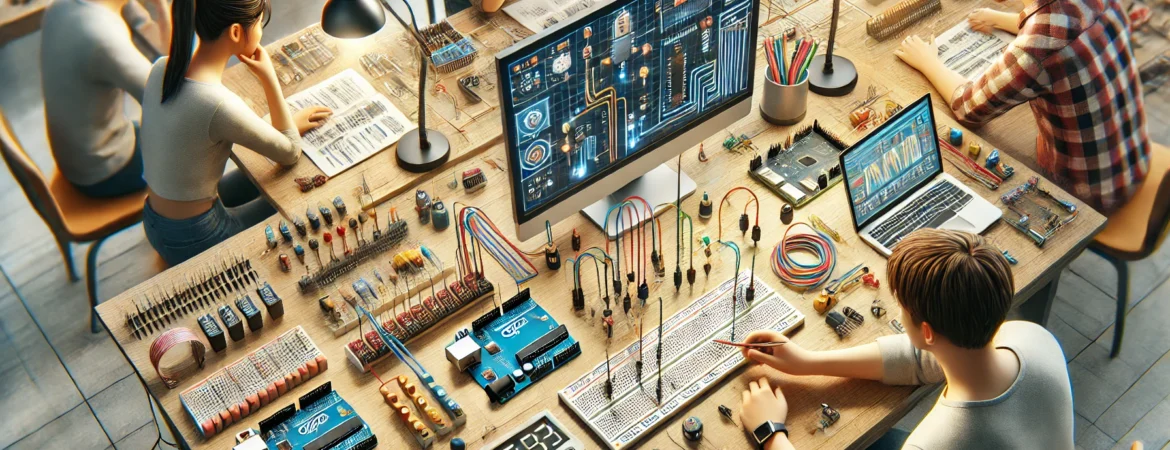1. Introduction to Electronic Components and Sensors
Electronics is the foundation of modern technology, enabling the development of smart devices, automation, and robotics. Understanding basic electronic components and sensors is essential for designing functional circuits and robotic systems. This article covers the key electronic components, their functions, and how sensors interact with these systems to collect and process data.
2. Basic Electronic Components and Their Functions
2.1. Resistors
Resistors limit the flow of electrical current in a circuit. They are used to protect components from excessive current and to control voltage levels.
- Unit: Ohm (Ω)
- Formula: Ohm’s Law → V = I × R
- Example Use: LED current limiting, voltage dividers.
2.2. Capacitors
Capacitors store electrical energy temporarily and release it when needed. They help stabilize power supply and filter noise in circuits.
- Unit: Farad (F)
- Example Use: Power supply stabilization, frequency filtering.
2.3. Diodes
Diodes allow current to flow in only one direction, preventing backflow that could damage circuits.
- Types:
- Rectifier Diodes: Convert AC to DC.
- Light Emitting Diodes (LEDs): Emit light when current passes through.
- Zener Diodes: Maintain a stable voltage.
2.4. Transistors
Transistors act as electronic switches or amplifiers. They are essential in microcontrollers and computing devices.
- Types:
- Bipolar Junction Transistor (BJT)
- Field Effect Transistor (FET)
2.5. Integrated Circuits (ICs)
ICs contain multiple electronic components, such as transistors, resistors, and capacitors, within a small package.
- Examples: Microcontrollers (Arduino, Raspberry Pi), Operational Amplifiers.
2.6. Power Supply Units
Every electronic system requires a power source, such as:
- Batteries (DC power).
- Power Adapters (convert AC to DC).
- Solar Panels (renewable power source).
3. Introduction to Sensors
Sensors detect environmental conditions and convert them into electrical signals. They are used in robotics, automation, and IoT systems to enable devices to respond intelligently to surroundings.
3.1. Types of Sensors and Their Applications
3.1.1. Temperature Sensors
Measure temperature changes in the environment.
- Examples: LM35, DHT11.
- Applications: Smart thermostats, weather monitoring.
3.1.2. Light Sensors
Detect the intensity of light.
- Examples: LDR (Light Dependent Resistor).
- Applications: Automatic street lights, solar tracking systems.
3.1.3. Motion Sensors
Detect movement in an area.
- Examples: PIR (Passive Infrared), Ultrasonic Sensors.
- Applications: Security systems, automation.
3.1.4. Distance Sensors
Measure the distance between objects.
- Examples: Ultrasonic Sensor (HC-SR04), LiDAR.
- Applications: Obstacle avoidance in robotics.
3.1.5. Gas Sensors
Detect harmful gases in the air.
- Examples: MQ-2, MQ-135.
- Applications: Air quality monitoring, fire detection.
4. Working with Sensors: Example – Using an Ultrasonic Sensor with Arduino
4.1. Circuit Setup
Components required:
- Arduino Uno.
- Ultrasonic Sensor HC-SR04.
- Breadboard and jumper wires.
4.2. Code Example
cppKopyalaDüzenleconst int trigPin = 9;
const int echoPin = 10;
void setup() {
Serial.begin(9600);
pinMode(trigPin, OUTPUT);
pinMode(echoPin, INPUT);
}
void loop() {
digitalWrite(trigPin, LOW);
delayMicroseconds(2);
digitalWrite(trigPin, HIGH);
delayMicroseconds(10);
digitalWrite(trigPin, LOW);
long duration = pulseIn(echoPin, HIGH);
int distance = duration * 0.034 / 2;
Serial.print("Distance: ");
Serial.print(distance);
Serial.println(" cm");
delay(500);
}
This program measures the distance of objects using the HC-SR04 sensor and displays the results on the serial monitor.
5. Conclusion
Understanding basic electronic components and sensors is fundamental in designing intelligent systems. Whether in robotics, IoT, or automation, these components play a crucial role in gathering data and controlling hardware. Learning how to integrate sensors with microcontrollers like Arduino opens up endless possibilities for developing smart technologies.
Elektronik Bileşenler ve Sensörler: Temel Elektronik Bileşenlerin Kullanımı ve Sensörlerle Çalışma
1. Elektronik Bileşenler ve Sensörlere Giriş
Elektronik, modern teknolojinin temelidir ve akıllı cihazların, otomasyon sistemlerinin ve robotların geliştirilmesini sağlar. Temel elektronik bileşenleri ve sensörleri anlamak, işlevsel devreler ve robotik sistemler tasarlamak için önemlidir.
2. Temel Elektronik Bileşenler ve Görevleri
2.1. Dirençler
Elektrik akımını sınırlayan bileşenlerdir.
- Birim: Ohm (Ω)
- Kullanım Alanları: LED parlaklık kontrolü, voltaj bölücüler.
2.2. Kapasitörler
Elektrik enerjisini geçici olarak depolar ve gerektiğinde boşaltır.
- Kullanım Alanları: Güç kaynağı stabilizasyonu, filtreleme devreleri.
2.3. Diyotlar
Elektriğin tek yönlü akmasını sağlar.
- LED’ler: Işık yayar.
- Zener Diyotlar: Sabit voltaj sağlar.
2.4. Transistörler
Elektronik anahtar veya amplifikatör olarak kullanılır.
- Tipler: BJT, FET.
2.5. Entegre Devreler (ICs)
Mikrodenetleyiciler ve işlemciler gibi birçok bileşeni içeren çiplerdir.
- Örnekler: Arduino, Raspberry Pi.
3. Sensörlere Giriş
Sensörler, çevresel koşulları algılar ve bunları elektrik sinyallerine dönüştürür.
3.1. Sensör Türleri ve Kullanım Alanları
- Sıcaklık Sensörleri: Akıllı termostatlar.
- Işık Sensörleri: Otomatik aydınlatma sistemleri.
- Hareket Sensörleri: Güvenlik sistemleri.
- Mesafe Sensörleri: Robotik engel algılama.
- Gaz Sensörleri: Hava kalitesi izleme.
4. Sensörlerle Çalışma: Örnek – Arduino ile Ultrasonik Sensör Kullanımı
4.1. Devre Kurulumu
- Arduino Uno
- HC-SR04 Ultrasonik Sensör
- Breadboard, Jumper Kablolar
4.2. Örnek Kod
cppKopyalaDüzenleconst int trigPin = 9;
const int echoPin = 10;
void setup() { ... }
void loop() { ... }
Bu kod, ultrasonik sensörü kullanarak nesne mesafesini ölçer.
5. Sonuç
Elektronik bileşenleri ve sensörleri anlamak, akıllı sistemler tasarlamak için kritik öneme sahiptir. Bu bilgiler, IoT ve robotik gibi alanlarda inovasyon için temel sağlar.
